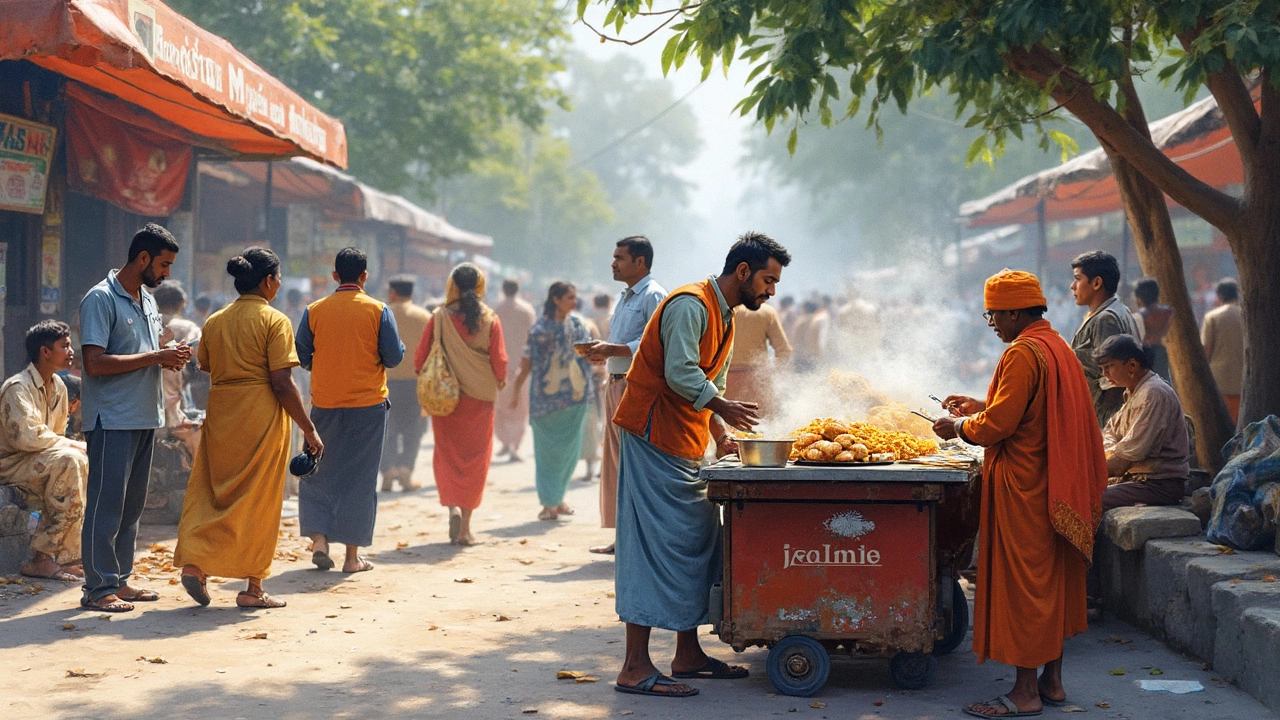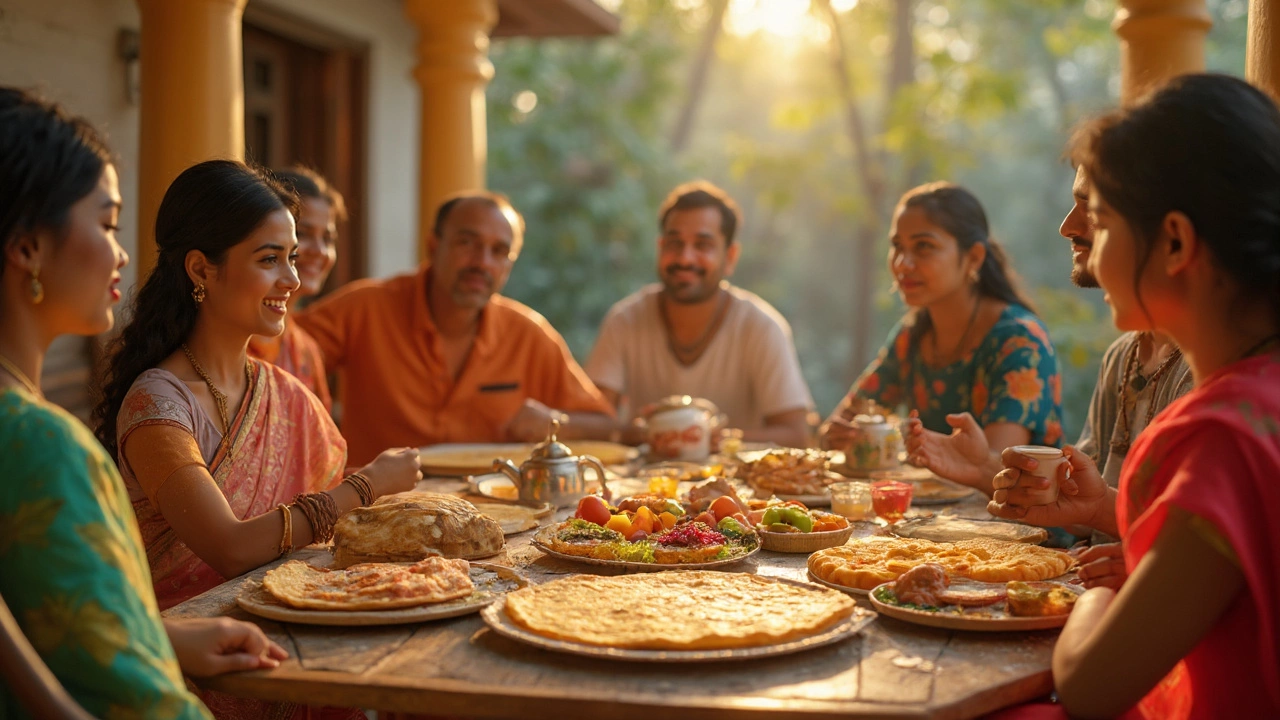Forget about plain toast and cereal for a minute. Indian breakfast is a riot of flavors, colors, and textures that can stun the senses before your day even starts. You might have heard of masala chai or samosas, but those are just the tip of the iceberg. Across India’s vast landscape, breakfast transforms with each state’s customs, language, and climate. It’s more than just food—breakfast in India is woven into everyday rituals, family bonding, and local culture. Get ready for a flavorful tour through the bustling mornings of the country, from the snowy hills of Kashmir to the tropical coasts of Kerala.
The Core Flavors and Staples of Indian Breakfast
Indian breakfast is not a one-size-fits-all affair. It changes with the region and season, and often what’s grown nearby finds its way to the breakfast table. Yet, some themes just run through Indian mornings like a thread. The heart of most traditional Indian breakfasts lies in grains and legumes—think wheat, rice, lentils, and chickpea flour. These are transformed into hearty dishes by cooking, steaming, frying, or fermenting, depending on where you are.
Let’s talk about the all-stars. Roti or paratha (flatbreads) made from wheat flour show up almost everywhere in north India. Usually toasted on a hot griddle, they’re sometimes stuffed with spicy mashed potatoes, cauliflower, or paneer (fresh cheese). Pair that with a generous dollop of butter or yogurt, and maybe a tangy homemade pickle on the side. Want a protein punch? Many households add dal (lentil curry) or egg preparations to the mix, especially in the Punjab region, where mornings start cold and hearty meals keep you energized.
Head down south and things shift dramatically. Rice is the queen here, and breakfast is often built on it. Steamed idlis—small, fluffy rice cakes—are a breakfast staple. You’ll also find dosas, which are thin, crisp pancakes made from a fermented rice and urad dal (black lentil) batter. They’re perfect for dipping in coconut chutney or spicy sambar, a soupy lentil-and-vegetable curry that’ll wake you up faster than any cup of coffee.
Don’t forget poha, flattened and lightly spiced rice, which is beloved in states like Maharashtra and Madhya Pradesh. The addition of peanuts, turmeric, and fresh coriander gives it a deep comforting flavor. And yes, let’s not skip over upma—a warm, soft semolina dish studded with vegetables and sometimes nuts, treasured in Karnataka and Tamil Nadu homes.
People love a savory start in India, but there’s room for sweet cravings too. Halwa, a soft, fragrant sweet made from semolina, or sheera with banana and cardamom, is often served as a treat. Milk-based sweets, like rasgulla or sandesh in Bengal, could even sneak onto the breakfast plate after a festival night. No two days ever look quite the same, but you’ll rarely be bored by repetition.
Here’s one quirky fact: many Indians start their breakfast with a cup of chai—a black tea simmered with milk, sugar, and a jumble of spices like ginger, cardamom, and cinnamon. It’s a story in a cup, with each family jealously guarding their own blend. In south India, strong coffee filtered through a steel percolator rules instead. It’s not just about taste; that hot drink is a morning ritual, almost a quiet meditation before the hustle begins.
Regional Variations: Breakfast Across the Indian Subcontinent
If you ever travel by train across India, peek into breakfast stalls at every stop—they serve as a living timeline of history, trade, and migration. The diversity is staggering. In Bengal, mishti doi (sweetened yogurt) and luchi (puffed bread) take the spotlight, sometimes with cholar dal—spiced Bengal gram stew. Assam’s breakfasts are simpler: rice served with curried vegetables, poha, or sticky apong rice for special days.
Move up to the snowy north and Kashmir’s breakfast is quite the contrast: bread like girda or sheermal paired with noon chai, a salty pink tea brewed with baking soda and sprinkled with almonds. It’s a flavor that might surprise first-timers. Farther down, in Gujarat, you’ll find fluffy khaman dhokla—steamed cakes of chickpea flour seasoned with green chili, ginger, and sweet mustard seeds. Served with green coriander chutney, they’re as light as clouds but wake up your taste buds.
Western India, particularly Mumbai, has another favorite—vada pav, which is basically a spicy mashed potato fritter stuck in a bun and slathered with garlic, tamarind, and green chutneys. It’s quick, filling, and an example of how Indian breakfasts flex to urban hustles. People in Goa treat themselves to poi (local bread) with chorizo or coconut-and-jaggery fillings. In the southern state of Kerala, mornings start with appam—lacy, bowl-shaped pancakes made from fermented rice batter—served with vegetable stew, sweetened coconut milk, or even spicy egg roast. Malabar paratha (flaky layered flatbread) is another regional specialty, usually with a creamy chickpea curry or meat stew.
You can’t ignore the influence of community and religion in Indian morning meals. Many Jain families avoid root vegetables—so their breakfast menus leave out onion, garlic, and sometimes even potatoes. Ramadan mornings in Hyderabad feature haleem—wheat, lentil, and meat stew topped with fried onions and lemon wedges. Sikhs, especially in Punjab, might start special mornings with a helping of kara prashad (wheat halwa made at gurdwaras) eaten alongside simple tea and savories.
Walk through a street in Chennai, and you might spot people queuing for hot idlis, dosas, and pongal (a savory rice dish with cashews and ghee) at a roadside cart. The western state of Rajasthan wakes up to missi roti (gram flour flatbread) paired with spicy aloo sabzi and homemade butter. Up north in Delhi, famous roadside stalls sell chole bhature: deep-fried bread with fiery chickpea curry. The sheer volume of oil or butter used in some northern dishes could shock health-conscious visitors, but for locals, it’s part of the charm, signaling weekend indulgence or festive mood.
Breakfast in India reflects geography, tradition, and weather just as much as it does taste. Coastal regions love their fish curries and coconut-based dishes; mountainous north India leans on heavy breads and curries so people can make it through cold mornings. Local festivals and seasons decide what pops up on the breakfast table, so even visitors during the monsoon might notice small tweaks in the menu—a pile of steaming pakoras with chai during a rainy day in July, or sweet puris during Holi celebrations in March.

Eating Breakfast Like a Local: Customs, Etiquette, and Rituals
Breakfast in India isn’t usually rushed. For many, it’s a family event, served hot and fresh straight from the kitchen. There’s something warm about that first whiff of ghee or the sizzle of spices hitting the tawa (griddle). It’s common for everyone to sit together on the floor or at a table, eating with their right hand—utensils are optional, but definitely not the norm in most homes. Try scooping a mouthful of poha or breaking a dosa with your fingers; it just tastes better that way, or so every Indian aunt will swear.
Don’t be surprised if there’s generous sharing, some gentle teasing, and a bit of bargaining over who gets the last helping of chutney. Indian breakfasts are not only about the food—they’re the stage for stories, announcements, and even mini family meetings. There’s almost a sacredness to these mornings, especially in rural areas, where the family’s daily rhythm kicks off with breakfast prayers or a quick devotional song played from a phone.
Visiting someone’s home? Refusing a breakfast invitation can be seen as rude. Accept at least a cup of tea, or risk a deeply wounded host. Some families top off the meal with a tiny steel container of “mukhwas”—spiced and sweetened seeds or fennel—for fresh breath. At festivals and special occasions, breakfast becomes grand: think mounds of sweets, fried breads, and even elaborate rice dishes laced with saffron.
Restaurants and cafes have jumped on the breakfast bandwagon, especially in large cities. That means you can get a full North Indian breakfast thali—a huge platter—with multiple breads, vegetable curries, yogurt, fried snacks, and sweets. South Indian breakfast “combos” aren’t rare either: a spread of idli, dosa, vada (fried lentil donuts), sambar, chutneys, and dessert. Hotels often combine these with Western staples like cornflakes and fresh fruit, but nobody beats homemade masala omelets with green chilies, tomatoes, and coriander chopped in.
Time is a big factor too. Rural areas start early, as do large families, but in cities, younger people might have just a cup of chai or a bowl of ready-to-eat cereal when pressed for time. But on weekends, breakfast transforms into an unhurried ritual—dishes become richer, and everyone lingers longer. The savory scent of ghee or butter, the gentle hum of conversation, and the swirl of spices in the air make for a scene you won’t find anywhere else.
And here’s a tip if you’re new to Indian breakfasts: start with something mild like poha or upma, then graduate to spicy misal pav or fiery chole bhature. Watch your spice tolerance and keep yogurt or a sweet as a sidekick. Wash everything down with chai, and you’re set for the day.
Tips for Trying Authentic Indian Breakfast—At Home or When Visiting
If you want to bring a piece of India into your kitchen, you don’t need to be a culinary expert. Some breakfast staples are surprisingly easy. For classic South Indian idlis, you only need rice, urad dal, and a little patience for the fermentation process. Dosas are trickier but get easier with practice—invest in a good non-stick skillet and try different fillings. Poha can be whipped up in under 30 minutes. Up north, attempt parathas with leftover mashed veggies or simply knead in some spices for a quick bread to pan-roast with ghee.
One universal tip: never skip the chutneys or pickles. Green coriander chutney, coconut chutney, or mango pickle add a hit of flavor you’ll miss if you try eating these dishes plain. For sweets, try suji ka halwa or sheera. It’s simple, with semolina, ghee, sugar, and cardamom, and is loved as much by kids as by adults.
If you’re traveling, wake up early and try a street-side breakfast vendor. In Mumbai, ask for misal pav at a local canteen. Down south, don’t let the queues at dosa stalls deter you—the best food is found where people are willing to wait. In Kolkata, find a sweet shop and ask for luchi with alur dom (a mild potato curry). In Rajasthan, look for kachoris—a flaky stuffed pastry—paired with tamarind chutney. Be bold in the markets, but if you have a sensitive stomach, stick to freshly-cooked hot food. Avoid raw salads until your system feels settled.
And a little trivia to impress your foodie friends: did you know that the largest dosa ever was 53 feet long? Or that chaiwallas (tea vendors) on the train platforms in India serve millions of cups of masala chai every single day? Breakfast isn’t taken lightly here—every bite is packed with stories, memory, and celebration.
Real Indian breakfast is about waking up your taste buds, but also about community—sharing warmth and sustenance before the day’s chaos sets in. Give it a shot at home, and you might find yourself looking forward to your morning alarm for once. If you ever get the chance to try it in India, don’t hold back—this is one tradition you want to savor to the last bite.
